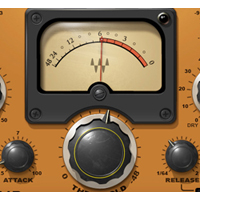
Waves intends the meter to show you total gain reduction of the audio, but I’d still like to know how much the compressor is working because it may not be noticeable with an appreciable amount of dry signal mixed in.
Another old-school “pie in the sky” wish is granted with the Punch control. This control mixes the input signal’s transient information into the output for more apparent loudness or punch.
The effect is not subtle and I liked it on most sources—I used it a lot on bass guitars and bright rhythm guitar tracks because it kept the front or attack of the notes yet did not cause the output to increase very much.
BPM-based release time programmability was unheard of ‘back in the day.’
For limiter special effects on percussion overdubs, I used to manually “ride” or “play” the release control on an UA 1176LN Peak Limiter during the recording. Fairchild 670s, LA-2As, RCA BA-6As, et al, do not have variable release time knobs.
In addition to seconds or milliseconds (ms), H-Comp lets you set release times predicated on the session’s tempo or any subdivision.
For example: severely compress a snare drum and set the release to the elapse time between quarter notes so that the compressor returns from gain reduction in time for another snare hit on the next backbeat. All good in theory until the drummer plays a drag or an eighth note fill between backbeats!
H-Comp Goes To Work
On bass guitar I compared the TDM version of H-Comp with the URS 1970-C compressor. With the same settings on both plug-ins and with both Punch and Analog controls set to zero on H-Comp, H-Comp had a nice clarity although I was happier with the vintage “dustiness” of Bobby Nathan’s URS compressor.
But all I had to do was add in some of H-Comp’s Analog control and a sound reminiscent of analog tape modulation noise or harmonic distortion from super hot tape recording levels got mixed in—it’s most noticeable at the maximum setting at 4.
Another apples to oranges comparison was between H-Comp (in RTAS mode) with SSL’s Duende X-Comp plug-in on a female lead vocal. Again with Analog off and no Punch introduced and with all settings matched in value, I found H-Comp to sound fatter and a little louder. It’s like comparing a modern compressor to an old tube stalwart—no clear winner—each has its place and value.
H-Comp has automatic gain makeup output level that I had to lower about 1.5 dB to match the vocal mix level. I like the automatic gain makeup but I wish there was a way to defeat it especially for making A/Bs.
Another good use for H-Comp was on snare drum tracks. The Wet/Dry Mix control, working like a parallel compression setup, mixes the sound of a heavily squashed snare drum (set to fastest attack time to get more sustain and ring and less attack) with the dry signal’s original sound with the attack portion of the sound. I set the Wet/Dry to about 60 percent Wet.
